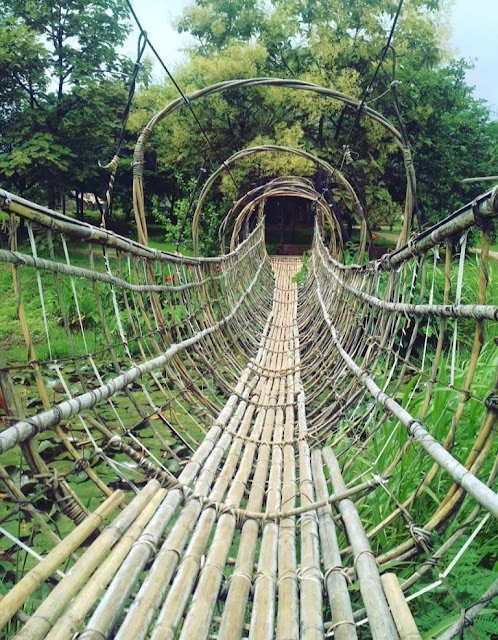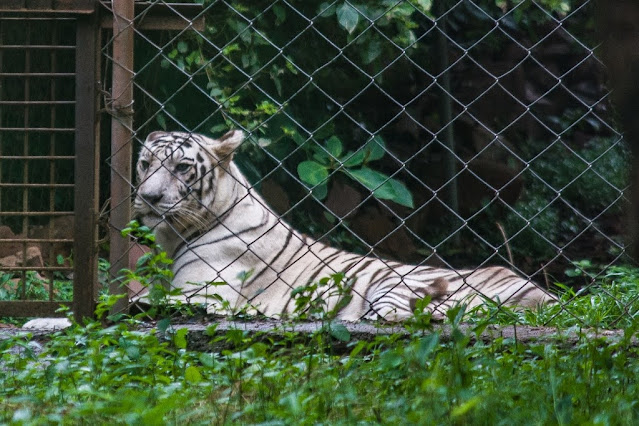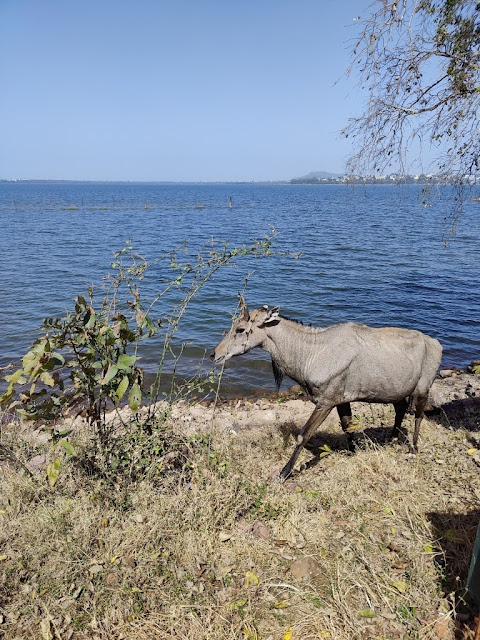Van Vihar National Park,
Bhopal – The National Park
The national park covers an area of about 4.45 sq kms. It has the status of a
national park but is developed and managed as a modern zoological park,
following the guidelines of the Central Zoo Authority. Animals are kept in
near natural habitats. Most of the animals are either orphaned and brought from
various parts of the state or are exchanged from other zoos. No animal is
deliberately captured from the forest. This park is unique because visitors
access it from a road through the park, and trenches, walls, and chain-link
fencing protect the animals from poachers while providing natural habitat. The park is maintained by the Forest Department of Madhya Pradesh. The park
administration is headed by a director of the rank of chief conservator of
forests and assisted by one assistant director, 3 range officers, 3
deputy-rangers, 4 foresters and 24 forest guards.



The park
administration is promoting cycling in the park; bicycles can be rented inside the
park gates at either end of the park. There are two entry points to this park
namely Chickoo Dwar and Ramu Dwar. The Chickoo Dwar is situated on the end of
Lake View Road while Ramu Dwar is towards Bhadbhada Bridge / Prempura Ghat end.
Visitors can take their own vehicles / hired vehicles inside after paying
appropriate fees. However, walking through the park is one of the best options
though consumes a lot of time as it is a 5 Km long road. Rental bicycles or
electric Golf Carts are also available to explore the park.
Flora:
This national park comprises of dry deciduous mixed forests. This park is home to at
least 700 species of plants. Some of the trees found in the park are Gum Lac
Tree, Indian Kino Tree, Indian Ash Tree, Yellow Flame Tree, Garlic pear, Purple
Orchid Tree, Maple-leaved Bayur tree, Indian date, White Bark Acacia, Ceylon
Tea, East Indian Ebony, Indian beech Tree, Small Flowered Crape Myrtle, Indian
Butter Tree, Indian Devil Tree, Giant Thorny bamboo, Assyrian plum, North
Indian rosewood, East Indian rosewood, Flame of the Forest, Golden rain tree,
Indian fig tree, Lipstick tree, Datranga, Kaim, Kadamba, Dhaman, and Bahera. The
grasses species found in the park are Apluda, Bothriochloa, Cenchrus, Cynodon,
Dicanthium, Eragrostis, Heteropogon, Saccharum, Themeda, Vetivera etc.
Fauna:
This national park categorizes the animals in two categories, captive and
herbivores. All carnivorous animals are kept inside enclosed areas and
herbivores are allowed to roam freely. The ponds located in the park is home to Indian
star tortoise, turtles, crocodiles, and a variety of fishes.
Captive
Animals:
The
captive animals are kept in a system of kraal and enclosures in lines of modern
concept of zoo management as per the norms of Central Zoo Authority. Some of
the captive animals are Bengal tiger, Asiatic lion, Asiatic
wildcat, Indian wolf, Sloth bear, Red fox, Indian
jackal, wild dog, mongoose, striped hyena, mugger
crocodile, gharial, and python. All felids and hyenas are
fed with buffalo meat, mutton, and poultry. Bears are provided with
milk, vegetables, fruits to make a balanced diet.
Herbivores:
Herbivores
are allowed to roam freely in the national park. Some of the herbivores are
gaur, chital, sambar, blackbuck, nilgai, four-horned
antelope, wild boar, porcupine, hare, Rhesus macaque, and common
langur. Normally the grass and other plant species growing in Van Vihar are
sufficient for these herbivores. However, in summer when the grass is scarce,
green fodder produced in the fodder farm and wheat husk procured from the
market is provided as a supplement.
Avifauna:
The park
is situated on the biggest manmade lake of Bhopal, the Upper Lake. This upper
lake provides a perfect habitat for the birds. The park is home to more than
210 species of birds. The park and the lake are visited by more than 80 species
of migratory birds during the winter. Some of the birds found in the park are Greater
coucal, Greater painted snipe, Greenish leaf warbler, Grey Francolin, Grey
headed flycatcher, Grey heron, Grey hornbill, Grey wagtail, Hoopoe, House swift,
House crow, House sparrow, Indian bush lark, Indian cormorant, Indian Courser, Indian
Cuckoo, Indian Jungle Nightjar, Indian robin, Indian roller, Indian treepie, Iora,
Jungle babbler, Jungle crow, Jungle prinia, Kentish Plover, Large cormorant, Large
Cuckoo Shrike, Large egret, Large grey babbler, Laughing dove, Lesser whistling
teal, Lesser white throat, Little Cormorant, Little egret, Little Grebe, little
green heron, Little Ringed Plover, Long tailed shrike, Mallard, Marsh harrier, Marsh
Sandpiper, Median egret, Mottled wood owl, Night heron, Northern pintail, Open
Bill Stork, Oriental magpie robin, Oriental tree pipit, Oriental white eye Osprey,
Paddy field pipit, Paddy field Warbler, Painted stork, Pariah kite, Peregrine
Falcon, Phesant tailed jacana, Pied bushchat, Pied crested cuckoo, Pied
kingfisher, Plain Prinia, Pond heron, Purple heron, Purple moorhen, Purple
sunbird, Red breasted flycatcher, Red collared dove, Red crested pochard, Red
munia, Red vented bulbul, Red wattled lapwing, River tern, Rose ringed parakeet,
Roufous Tailed Finch Lark, Sarus crane, Shikra, Shoveller, Silver billed munia,
Small blue kingfisher, Small green bee-eater, Small minivet, Spot billed duck, Spotted
dove, Spotted Munia, Spotted owlet, Spotted Sandpiper, Stork billed kingfisher,
Streak throated swallow, Temmincks Stint, Thick billed flowerpecker, Tickells
blue flycatcher, Verditer Flycatcher, Whiskered Tern, White Bellied Minivet, White
breasted kingfisher, White breasted waterhen, White browed fantail flycatcher, White
browed wagtail, White Ibis, White Necked Stork, White Rumped Munia, White Stork,
White wagtail, Wigeon, Wire tailed swallow, Wood sandpiper, Yellow Eyed Babbler,
Yellow fronted pied woodpecker, Alpine Swift, Ashy crowned sparrow lark, Ashy
prinia, Asian koel, Asian paradise flycatcher, Asian pied myna, Black redstart,
Black shouldered kite, Black tailed godwit, Black winged stilt, Blue cheeked
Beeater, Blue rock pigeon, Blue rock thrush, Blue Tailed Beeater, Bluethroat, Blyths
reed Warbler, Booted Eagle, Booted warbler, Brahminy shelduck, Brahminy
starling, Brainfever, Bristled grass bird, Bronze winged jacana, Brown capped
pigmy woodpecker, Brown Headed Gull, Brown rock chat, Cattle egret, Chestnut
Bittern, Bar headed goose, Barn owl, Bay backed shrike, Baya weaver, Black
Bellied Tern, Black drongo, Black Headed Cuckoo Shrike, Black Ibis, Common
tailorbird, Common teal, Common wood shrike, Coppersmith barbet, Cotton Teal, Crested
Bunting, Crested Lark, Crested Tree Swift, Darter, Dusky crag martin, Egyptian
vulture, Eurasian collored dove, Eurasian Curlew, Eurasian Eagle Owl, Chestnut
Headed Beeater, Citrine wagtail, Clamorous Reed Warbler, Comb duck, Common
babbler, Common Buttonquail, Common Coot, Common Greenshank, Common Grey Quail,
Common Indian Nightjar, Common Kestrel, Common moorhen, Common myna, Common
Peafowl, Common pochard, Common Redshank, Common Sandpiper, Common Snipe, Common
stonechat, Common Swallow, Chiffchaff, Green Sandpiper, Yellow Wattled Lapwing,
Yellow wagtail, Yellow throated sparrow, Great tit, Golden backed woodpecker, Garganey,
Glossy ibis, Gadwall, Franklins Prinia, Franklins Nightjar, Eurasian wryneck, Eurasian
Spoonbill, and Eurasian golden oriole.

.jpg)





.jpg)
















.jpg)




